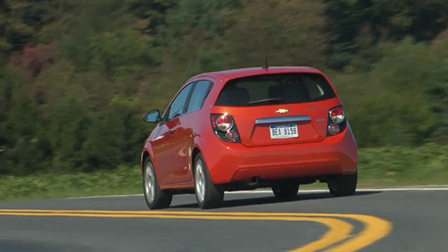March 4, 2014
Automakers Innovate With Clean Gas Technologies (Text Version)
This is a text version of the video segment Automakers Innovate With Clean Gas Technologies, which aired on March 4, 2014.
JOHN DAVIS: No one knows for sure what the car of the distant future will look like, or what will be its dominant fuel or type of power, but clearly, plug-in electric drive is the current king of clean motoring. As battery technology improves, more and more car makers are likely to make the jump to advanced hybrids and pure EVs. But as for today, choices among plug-in models remain limited, with high purchase price being an obstacle to wider acceptance. Fewer still are cars and trucks offering clean diesel power, although that number is growing. For the foreseeable future, the vast majority of vehicles will still be powered by gasoline engines, including traditional hybrids. So the pressure to deliver more fuel efficiency without compromising performance or convenience has led car makers to develop some amazing gas-engine-based technologies in recent years.
Terms like Mazda SkyActiv and Honda Earth Dreams may sound like marketing slogans, but they represent a holistic approach to maximizing MPG that may include turbocharging and engine downsizing, direct gas injection, variable valve timing, reducing internal friction, advanced transmissions, electric power steering, and HVAC systems, reducing weight, and under-car aerodynamics. Each bit of technology may return only a few tenths of a mile per gallon improvement, but when used together, they can deliver impressive gains. The 2010 Mazda3 2.5, for instance, carried fuel economy estimates of 22 city, 29 highway. Not bad, but the 2014 SkyActiv version ups that to 28 and 38, while also packing 17 more horsepower and a one-second quicker zero-to-60 time. Zoom zoom, indeed.
Every engine has a sweet spot or an RPM range that allows it to operate at peak efficiency. That's where the transmission comes into play. Belt-drive CVT, or continuously variable transmissions, match the exact gear ratio needed for any situation, delivering a super smooth if somewhat unfamiliar driving experience with impressive fuel economy. To provide even more options, designers of traditional trannys are following the lead of truckers by growing gears from four, five, and six to an unprecedented eight, nine, and 10 forward ratios. Often with two overdrive ratios, the newest automatics allow an engine to cruise along with low effort, thus again boosting fuel economy. The new Jeep Cherokee, with its nine-speed automatic, rates 22 miles per gallon city and 31 on the highway, a nice jump over the 21/28 rating of the smaller Jeep Compass with its six-speed. Aerodynamics have long played a role in vehicle efficiency, but while most attention in the past was on the body, more and more vehicles are now adding full underbody trays.
That plus even more wind-sculpting body work and the latest trick, active front grill shutters that shut off excess drag inducing airflow through the radiator at highway speeds, all are boosting fuel economy. And finally, it seems those golf carts had it right all along. Make note of the amount of time your car spends idling in a given day and how much fuel is wasted just sitting still. More and more car makers are adding automatic stop-start technology to reduce unnecessary idling and save gas. When the car reaches a complete stop, even momentarily, the engine computer cuts spark and fuel. Once the driver lifts off the brake or engages the clutch, the engine fires up instantly and off you go. The gasoline engine may one day be replaced by some yet-to-be-discovered clean renewable fuel, but thanks to innovative uses of both new and old technologies, it's cleaning up its act in the meantime.

